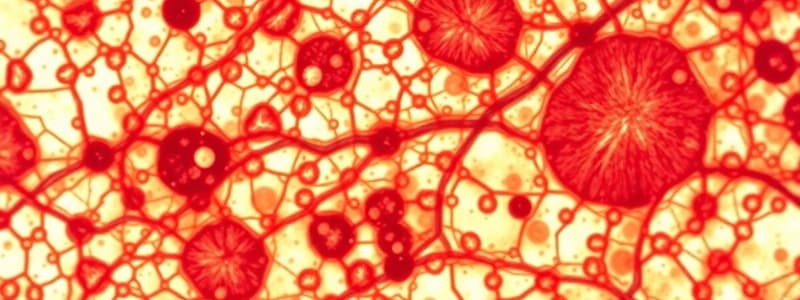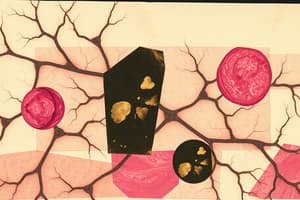Podcast
Questions and Answers
Which type of tissue is primarily responsible for covering and protecting the body?
Which type of tissue is primarily responsible for covering and protecting the body?
- Muscular tissue
- Nervous tissue
- Epithelial tissue (correct)
- Connective tissue
Nervous tissue is responsible for generating electrical signals called nerve impulses.
Nervous tissue is responsible for generating electrical signals called nerve impulses.
True (A)
What is the scientific study of tissues called?
What is the scientific study of tissues called?
Histology
Adherens junctions are connected to ____________ filaments to resist pulling forces.
Adherens junctions are connected to ____________ filaments to resist pulling forces.
Match the following types of cell junctions with their functions:
Match the following types of cell junctions with their functions:
Which of the following represents a type of epithelial tissue specialized for absorption and secretion?
Which of the following represents a type of epithelial tissue specialized for absorption and secretion?
Transitional epithelium maintains the same shape regardless of whether it is stretched or at rest.
Transitional epithelium maintains the same shape regardless of whether it is stretched or at rest.
What are the two layers that make up the basement membrane?
What are the two layers that make up the basement membrane?
In stratified squamous epithelium, the cells can be _____ when they are sloughed off for protection.
In stratified squamous epithelium, the cells can be _____ when they are sloughed off for protection.
Match the following types of epithelial tissues with their primary functions:
Match the following types of epithelial tissues with their primary functions:
Which type of gland secretes products by rupturing mature cells?
Which type of gland secretes products by rupturing mature cells?
Epithelial tissue is typically vascularized.
Epithelial tissue is typically vascularized.
What are the three types of fibers found in the extracellular matrix of connective tissues?
What are the three types of fibers found in the extracellular matrix of connective tissues?
Merocrine glands secrete products via __________.
Merocrine glands secrete products via __________.
Match the following types of connective tissues to their features:
Match the following types of connective tissues to their features:
Flashcards are hidden until you start studying
Study Notes
Tissues
- A tissue is a group of cells that work together to perform a specific function.
- Tissues are derived from a common progenitor cell.
- The four main types of tissues in the human body are:
- Epithelial tissue
- Connective tissue
- Muscular tissue
- Nervous tissue
- Histology is the scientific study of tissues.
Epithelial Tissue
- Covers and protects the body and lines hollow organs
- Forms glands
- Specialized for exchange with the environment
- Can be simple, stratified, or pseudostratified
- Can be squamous, cuboidal, columnar, or transitional
- Epithelial cells are polarized, with apical, basal, and lateral surfaces
Connective Tissue
- Protects and supports the body and internal organs
- Connects organs together, stores energy, and aids immunity
- Contains cells and extracellular matrix (ECM)
- ECM is made of protein fibers and ground substance
- Cells include fibroblasts, macrophages, plasma cells, mast cells, adipocytes, and leukocytes.
- Protein fibers within the ECM include collagen, elastic, and reticular fibers
Muscular Tissue
- Made of specialized cells that contract to generate force.
- Generates body heat
- Types include skeletal, cardiac, and smooth.
Nervous Tissue
- Detects and responds to stimuli
- Generates electrical signals called nerve impulses
- Stimulates changes in muscle or gland action
Cell Junctions
- Sites of contact between adjacent cells
- Types of cell junctions include:
- Tight junctions: leakproof connections
- Adherens junctions: resist pulling force
- Desmosomes: resist contraction
- Hemidesmosomes: anchor cells to underlying tissues
- Gap junctions: protein channels that connect cell membranes
Basement Membrane
- Separates epithelial tissue from underlying connective tissue
- Made of two layers: basal lamina and reticular lamina
Surface Epithelium
- Simple squamous epithelium: specialized for filtration and diffusion
- Simple cuboidal epithelium: specialized for secretion and absorption
- Non-ciliated simple columnar epithelium: specialized for secretion of mucus and absorption of nutrients
- Ciliated simple columnar epithelium: specialized for protection from invasion and fluid loss
- Non-ciliated pseudostratified columnar epithelium: specialized for absorption of substances and secretion
- Ciliated pseudostratified columnar epithelium: specialized for protection from invasion
- Stratified squamous epithelium: specialized for protection from abrasion, fluid loss, and invasion
- Stratified cuboidal epithelium: specialized for protection from abrasion
- Stratified columnar epithelium: specialized for protection from invasion and secretion
- Transitional epithelium: variable in shape and specialized for stretching
Glandular Epithelium
- Secretion to protect the body
- Glands can be exocrine or endocrine
- Exocrine glands secrete substances a short distance
- Endocrine glands secrete substances into the blood
- Exocrine glands can be unicellular or multicellular
- Multicellular exocrine glands can be merocrine, apocrine, or holocrine
Connective Tissue
- Types of connective tissue:
- Embryonic: mesenchymal and mucoid
- Mature: loose (areolar, adipose, reticular) and dense (regular, irregular, elastic)
- Supporting: cartilage (hyaline, fibrocartilage, elastic) and bone
- Liquid: blood and lymph
- The main difference between epithelial and connective tissue is the ratio of ECM to number of cells.
Anatomical Membranes
- Sheets of flexible tissue that cover or line a portion of the body
- Types of anatomical membranes:
- Mucous membranes: line body cavities open to the external environment
- Serous membranes: line internal body cavities
- Cutaneous membranes: include skin
- Synovial membranes: line joints and contain only connective tissue
Muscular Tissue
- Made of myocytes that contract to move bones and generate heat
- Types include skeletal, cardiac, and smooth.
Nervous Tissue
- Contains excitable cells that detect electrical stimuli and respond by producing action potentials.
- Types include neurons and neuroglia.
Skeletal Muscle Tissue
- Long, multinucleate, striated tissue
- Produces voluntary movement, maintains posture, and generates heat
- Attaches to bones via tendons
Cardiac Muscle Tissue
- Branched, striated fibres with a single nucleus
- Cells joined by gap junctions for more rapid electrical signal conduction
- Under involuntary control
- Collectively forms the myocardium or heart wall
Smooth Muscle Tissue
- Long, nonstriated fibres in an irregularly-shaped cell with a single nucleus
- Thickened middle to cells
- Cells joined by gap junctions to coordinate involuntary muscle contractions
- Facilitates peristalsis, constriction of airways, contractions of the urinary bladder and gallbladder.
Nervous Tissue
- Two types of cells make up nervous tissue:
- Neurons: consist of a cell body, dendrites, and an axon, generate electrical signals or nerve impulses
- Neuroglia: do not generate electrical impulses, synthesize myelin = coating of neuronal axons to increase electrical signal transmission speed
Tissue Summary
- Tissues are composed of cells and extracellular matrix (ECM)
- Epithelial tissues cover and line the body
- Can secrete/absorb substances like hormones and nutrients
- Can protect from mechanical injury such as abrasion
- Connective tissues join epithelial tissues to deeper tissues and support the body
- Muscular tissue moves the body and generates heat
- Nervous tissue coordinates and controls the body’s response to stimuli
Studying That Suits You
Use AI to generate personalized quizzes and flashcards to suit your learning preferences.




